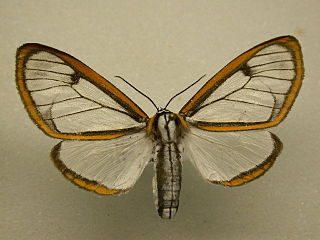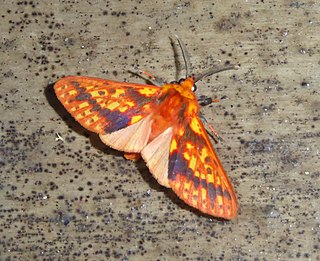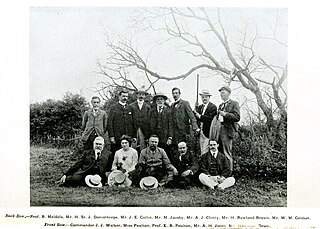
Poritiinae is a subfamily of butterflies, the larvae of which are unusual for feeding on algae and foliate lichen.
Herbert Druce, FLS was an English entomologist. His collections were acquired by Frederick DuCane Godman (1834–1919), Osbert Salvin (1835–1898), and James John Joicey (1870–1932) before being bequeathed to the Natural History Museum, London. He is not to be confused with his son, the English entomologist Hamilton Herbert Druce, who also worked on Lepidoptera.

Hestina is a genus of butterflies in the family Nymphalidae subfamily Apaturinae. The genus is found in the East Palearctic and Southeast Asia.

Amata is a genus of tiger moths in the family Erebidae. The genus was erected by Johan Christian Fabricius in 1807.
Disconeura is a genus of moths in the family Erebidae. The genus was erected by Felix Bryk in 1953.

Eucereon is a genus of tiger moths in the family Erebidae. The genus was erected by Jacob Hübner in 1819.

Iolaus is a genus of butterflies in the family Lycaenidae. The genera Argiolaus, Epamera, Iolaphilus and Stugeta are often included in Iolaus. Iolaus species are found in the Afrotropical realm.

Hyalurga is a genus of tiger moths in the family Erebidae. The genus was erected by Jacob Hübner in 1819.

Leucanopsis is a genus of moths in the family Erebidae. The genus was described by Alfredo Rei do Régo Barros in 1956.

Pilodeudorix is a genus of butterflies in the family Lycaenidae. They are found in the Afrotropical realm.

Symphlebia is a genus of moths in the family Erebidae. The genus was erected by Felder in 1874.

Virbia is a genus of tiger moths in the family Erebidae. The genus was erected by Francis Walker in 1854.

Patalene is a genus of moths in the family Geometridae erected by Gottlieb August Wilhelm Herrich-Schäffer in 1854.

Sabulodes is a genus of moths in the family Geometridae first described by Achille Guenée in 1857.
Polypoetes is a genus of moths of the family Notodontidae. It consists of the following species:
Afrospilarctia is a genus of tiger moths in the family Erebidae and are found in the Afrotropics.

Hamilton Herbert Charles James Druce was an English entomologist who specialised in Lycaenidae and to a lesser extent Hesperiidae. He is not to be confused with his father, the English entomologist Herbert Druce (1846–1913) who also worked on Lepidoptera.
Disconeura inexpectata is a moth of the family Erebidae first described by Walter Rothschild in 1910. It is found in Peru.

Apatelodes is a genus of moths of the family Apatelodidae first described by Packard in 1864.
Heteronygmia dissimilis is a species of moth in the subfamily Lymantriinae first described by Per Olof Christopher Aurivillius in 1910. It is native to Africa. The adult moth is on wing from February to November, but is most common between June and September. The larvae feed on the foliage of the East African mahogany and when they are plentiful, they can defoliate the tree.












